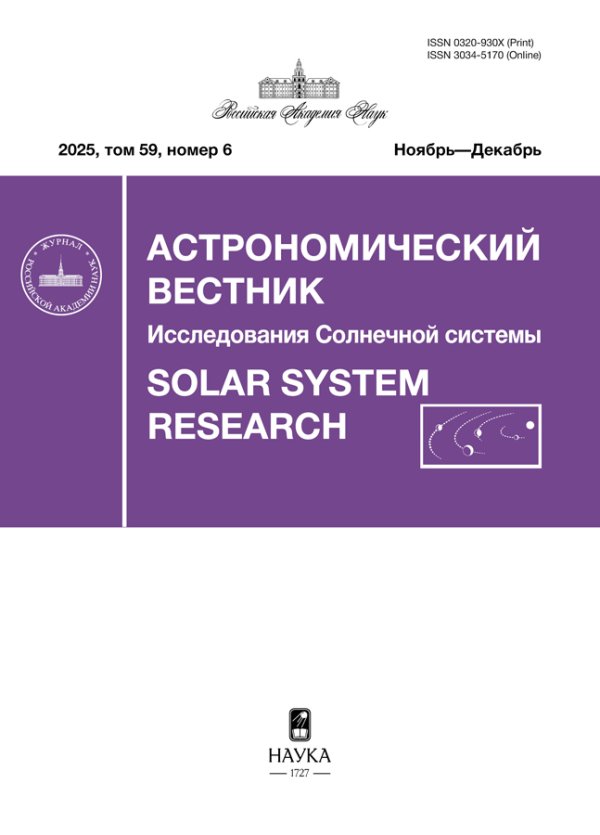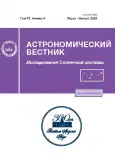Determination of the Motion Parameters of Near-Earth Objects from Position Measurements Performed at the Terskol Observatory
- Authors: Levkina P.A.1, Chuvashov I.N.2
-
Affiliations:
- Institute of Astronomy of the Russian Academy of Sciences, Moscow, Russia
- Tomsk State University, Tomsk, Russia
- Issue: Vol 57, No 4 (2023)
- Pages: 357-364
- Section: Articles
- URL: https://journals.rcsi.science/0320-930X/article/view/134982
- DOI: https://doi.org/10.31857/S0320930X23040060
- EDN: https://elibrary.ru/RENSOK
- ID: 134982
Cite item
Full Text
Abstract
The paper presents a method for processing positional observations of near-Earth objects using a numerical model of satellite motion developed at the Research Institute of Applied Mathematics and Mechanics of Tomsk State University (NII PMM TSU). The root-mean-square error of orbit improvement without rejection of observations for such objects does not exceed 0.3″ over a seven-day time interval. The results of the presentation of observations for the next occurrence of the object are obtained, which makes it possible to find the object in a time interval of five months. The orbit has been refined in the joint processing of measurements on several occurrences of the object over a six-month time interval. All results were obtained from observations made on the equipment of the Terskol Observatory Shared Use Center.
About the authors
P. A. Levkina
Institute of Astronomy of the Russian Academy of Sciences, Moscow, Russia
Email: ayvazovskaya@inasan.ru
Россия, Москва
I. N. Chuvashov
Tomsk State University, Tomsk, Russia
Author for correspondence.
Email: chuvashovin@gmail.com
Россия, Томск
References
- Авдюшев В.А. Численное моделирование орбит. Томск: Изд-во НТЛ, 2010. 282 с.
- Батурин А.П., Чувашов И.Н. Упрощенный способ определения начального приближения при улучшении орбит // Изв. вузов. Физика. 2006. № 2. Приложение. С. 52–55.
- Оголев А.В., Морозов С.В. Анализ засоренности околоземного космического пространства объектами техногенного происхождения и их влияние на функционирование космических аппаратов // Сб. трудов Всероссийской научной конференции с международным участием “Космический мусор: фундаментальные и практические аспекты угрозы”. М.: ИКИ РАН, 2019. С. 15–19.
- Aleksandrova A.G., Bordovitsyna T.V., Chuvashov I.N. Numerical modeling in problems of near-Earth object dynamics // Russian Phys. J. 2017. V. 60. № 1. P. 80–89.
- Bakhtigaraev N.S., Levkina P.A., Chazov V.V. Empirical model of motion of space debris in the geostationary region // Sol. Syst. Res. 2016. V. 50. № 2. P. 130–135.
- Hoots F., Roehrich R. Models for propagation of NORAD element sets // Spacetrack Report. 1988. № 3. 91 p.
- IERS Standarts. IERS Technical Note. Paris: Central Bureau of IERS, 1992. 150 p.
- Klinkrad H. Space Debris. Models and Risk Analysis. Berlin, Heidelberg: Springer, 2006. 430 p.
- Robertson H.P. Dynamical effects of radiation in the Solar System // Mon. Notic. Roy. Astron. Soc. 1937. V. 97. P. 423–438.
- Vokrouhlicky D., Farinella P., Mignard F. Solar radiation pressure perturbations for Earth satellites. 1. A complete theory including penumbra transitions // Astron. and Astrophys. 1993. V. 280. № 2. P. 295–312.
- Vokrouhlicky D., Farinella P., Mignard F. Solar radiation pressure perturbations for Earth satellites. 4. Effects of the Earth’s polar flattening on the shadow structure and the penumbra transitions // Astron. and Astrophys. 1996. V. 307. № 2. P. 635–644.
Supplementary files















